- Home
- About EXOTIC BENGALS - Exotic Legends
- NEW Kings (Pictures coming soon)
- NEW Queens
- Kittens
- F.A.Q
- Waiting List
- Recommendations
- Contact
- BENGAL COAT COLOR GENETICS - HOW WE DETERMINE THE COLORS/GENETICS OF FUTURE KITTENS/LITTERS
- CERTIFICATES AND AWARDS
- TRANSPORTING YOUR EXOTIC LEGENDS BENGAL
- BACK YARD BREEDERS - WATCH OUT
- Exotic Legends Bengal Water Sports (what a wonderful client video)
- Exotic Legends Bengal kitten playing in tha water with their fish friends -
- Exotic Legends Bengal Kitten Taking A Walk With Their New Family
- Exotic Legends Bengal Kittens At Their New Home
- Exotic Legends Bengal CAT - HANGING WITH HIS NEW FRIEND - client SAID HE IS SOOOO GENTLE WITH BABY
- Gallery
F.A.Q
What is the adoption fee (GIFT) for an Exotic Legends Bengal?
*WE GUARANTEE THAT WE WILL MATCH THE PRICE OF OTHER CURRENT, ACTIVE, REGISTERED, INSPECTED, REPUTABLE CATTERIES - LLC'S - THAT ARE TESTING THEIR BREEDERS, FOR THE SAME TESTS THAT WE DO: THAT ARE 100% NEGATIVE, AND PROVIDE PROOF OF TEST RESULTS, INSPECTION REPORTS, ACTIVE TICA OR CFA STATUS, AND CURRENT BUSINESS LICENSE.
Adoption fees (GIFTS) are subject to change (coloration/markings)
Pet prices (Gifts) usually range from $2,800 to $3,800 + PRICES ARE SUBJECT TO CHANGE BASED ON THE ECONOMY - This average price does not include discounts: as indicated below.
Breeding/show rights (Gifts of) PLEASE ASK (Breeding Bengals will not be sold (Gifted) in Washington State)
Discount of $100 off of your second Exoticlegends kitten.
Discount of $100 for Military and disabled individuals (must provide verification)
Adoption fees (GIFTS) are subject to change (coloration/markings)
Pet prices (Gifts) usually range from $2,800 to $3,800 + PRICES ARE SUBJECT TO CHANGE BASED ON THE ECONOMY - This average price does not include discounts: as indicated below.
Breeding/show rights (Gifts of) PLEASE ASK (Breeding Bengals will not be sold (Gifted) in Washington State)
Discount of $100 off of your second Exoticlegends kitten.
Discount of $100 for Military and disabled individuals (must provide verification)
What is included with my Bengal kitten? (As long as supplies last)
1. Spay/neuter (unless being purchased for breeding) or per contract
2. Micro-chipped (ISO) International Microchip
3. Up to date with shots
4. De-worming,
5. Sample food and/or coupon for food
6. Gift Bag
7. Toys
8. Vet Health Certification (If Flying)
9. Life-time support
10. Revolution (If supplies last)
11. TICA or CFA Registration papers
12. Folder containing parents test results, shot records, copy of contract, microchip information. CFA or TICA registration, veterinarian health reports.
2. Micro-chipped (ISO) International Microchip
3. Up to date with shots
4. De-worming,
5. Sample food and/or coupon for food
6. Gift Bag
7. Toys
8. Vet Health Certification (If Flying)
9. Life-time support
10. Revolution (If supplies last)
11. TICA or CFA Registration papers
12. Folder containing parents test results, shot records, copy of contract, microchip information. CFA or TICA registration, veterinarian health reports.
Can you ship the kitten to us?
We can ship your kitten anywhere in the United States AND internationally. (prices can be provided by the flight nanny you choose)
We also offer a DOOR TO DOOR service, for a fee of .56 cents a mile (Current IRS Rate)
We also offer a DOOR TO DOOR service, for a fee of .56 cents a mile (Current IRS Rate)
Does my (Gift) deposit count towards the adoption fee of my Bengal?
Yes your (Gift) deposit count towards your kitten.
HOWEVER, if you no longer would like a kitten from us, your deposit (gift) stays with us..
HOWEVER, if you no longer would like a kitten from us, your deposit (gift) stays with us..
What happens to my reservation (Gift) deposit if I don't pick a kitten or my living situation changes?
Your (Gift) deposit is safe with us. We will keep your (Gift) deposit and as soon as you are ready, your (Gift) deposit will go towards the adoption of your little angel.
HOWEVER - if you decide you no longer would like a kitten - your deposit (gift) stay with us.
HOWEVER - if you decide you no longer would like a kitten - your deposit (gift) stay with us.
What color OR styles Bengals do you have?



 1. Brown, Gold, Orange (with or without Glitter)
1. Brown, Gold, Orange (with or without Glitter)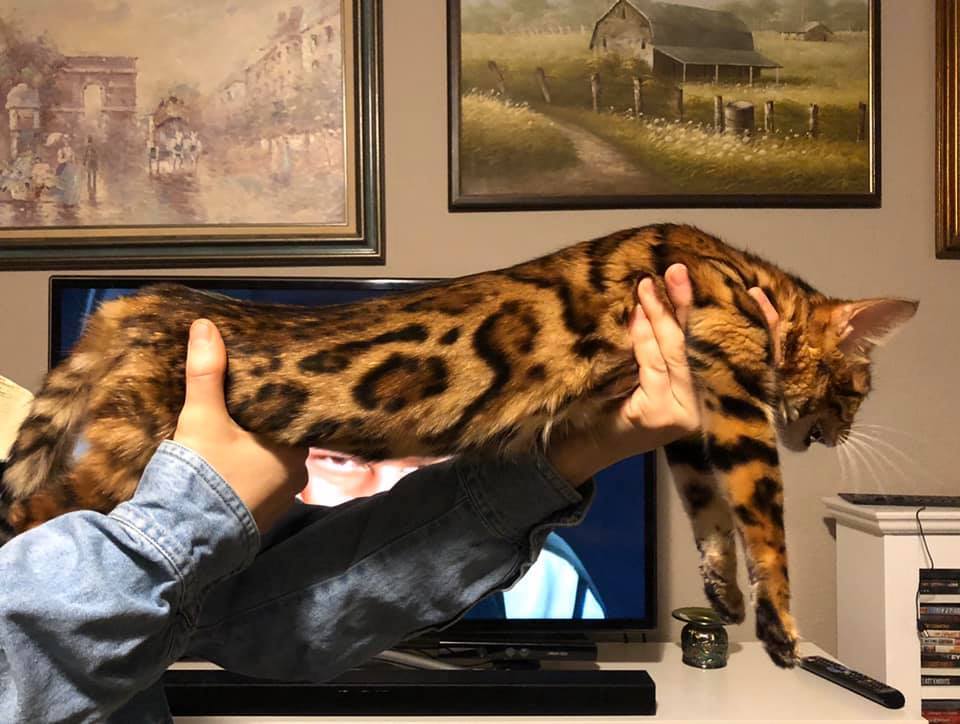 |  |  |
 |  |  |
2. Silver
 |  |  |
3. Snows:
SEAL LYNX POINT(Blue Eyes) LYNX POINT (BLUE EYE) - is the result of crossing an Asian Leopard cat with a Siamese cat. This produces a snow Bengal with a creamy white background, blue eyes, and contrasting markings. Most often, the snow lynx's pattern is pale or not visible at birth, and darkens as it grows.
 | 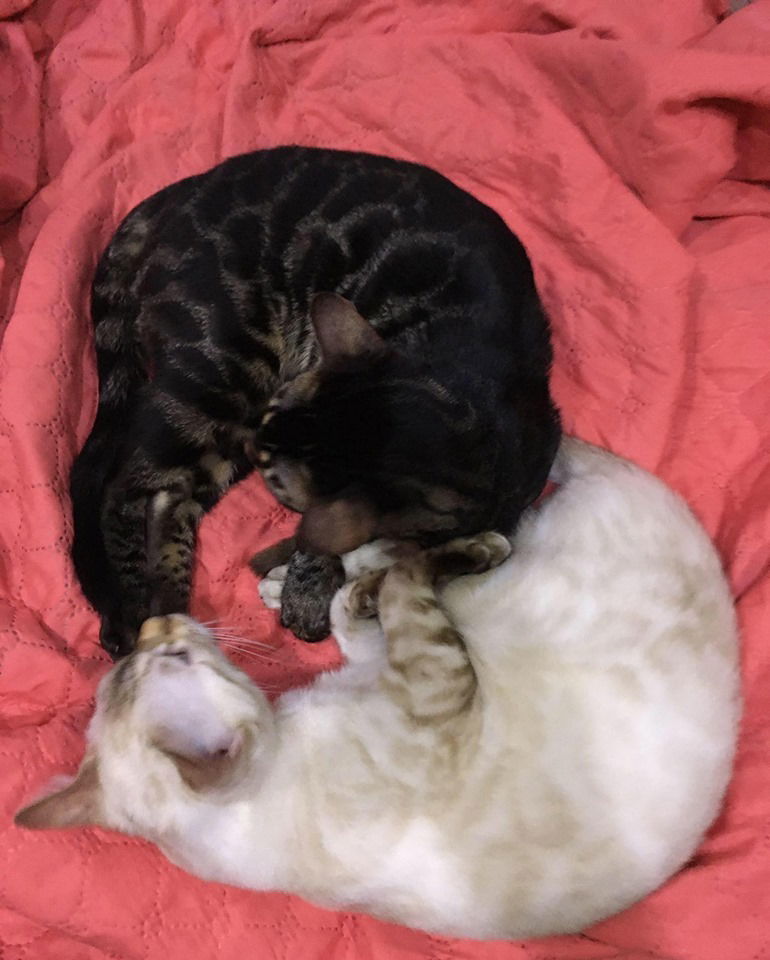 |  |
SEAL MINK (AQUA BLUE eyes) A snow mink, is a combination of the lynx and sepia. These kittens are darker than the lynx but lighter than the sepia. Most often, the eye color is aqua. At birth, these kittens have a pattern that is distinguishable.
 | 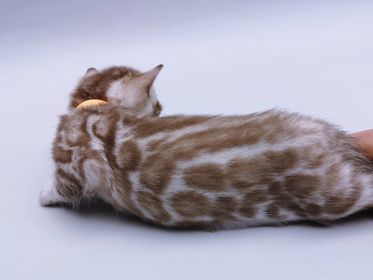 |  |
SILVER SEAL LYNX POINT (BLUE Eyes) White background - silver markings. (coming end of 2020 - beginning 2021)4. Charcoal (coming 2020)
 |  |  |
SEAL SEPIA - COMING END OF 2022 - 2003 - is the result of crossing an Asian Leopard cat with a Burmese cat.
The Seal Sepia is a green or gold eyed cat and are born with an almost chocolate pattern on white snow background. They are the darkest of the snow Bengals and their colour continues to develop till about 6-12months.
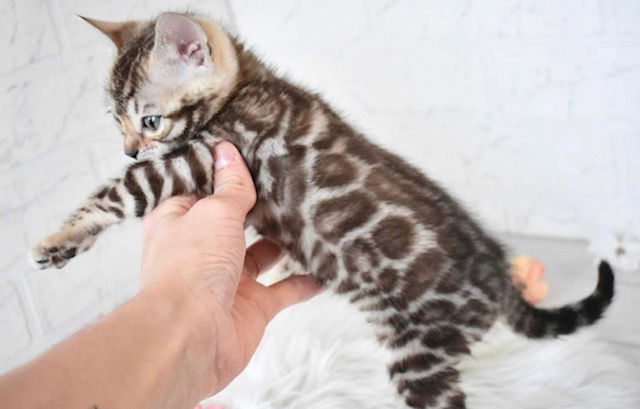
4. CHARCOAL - Apb/a
 | 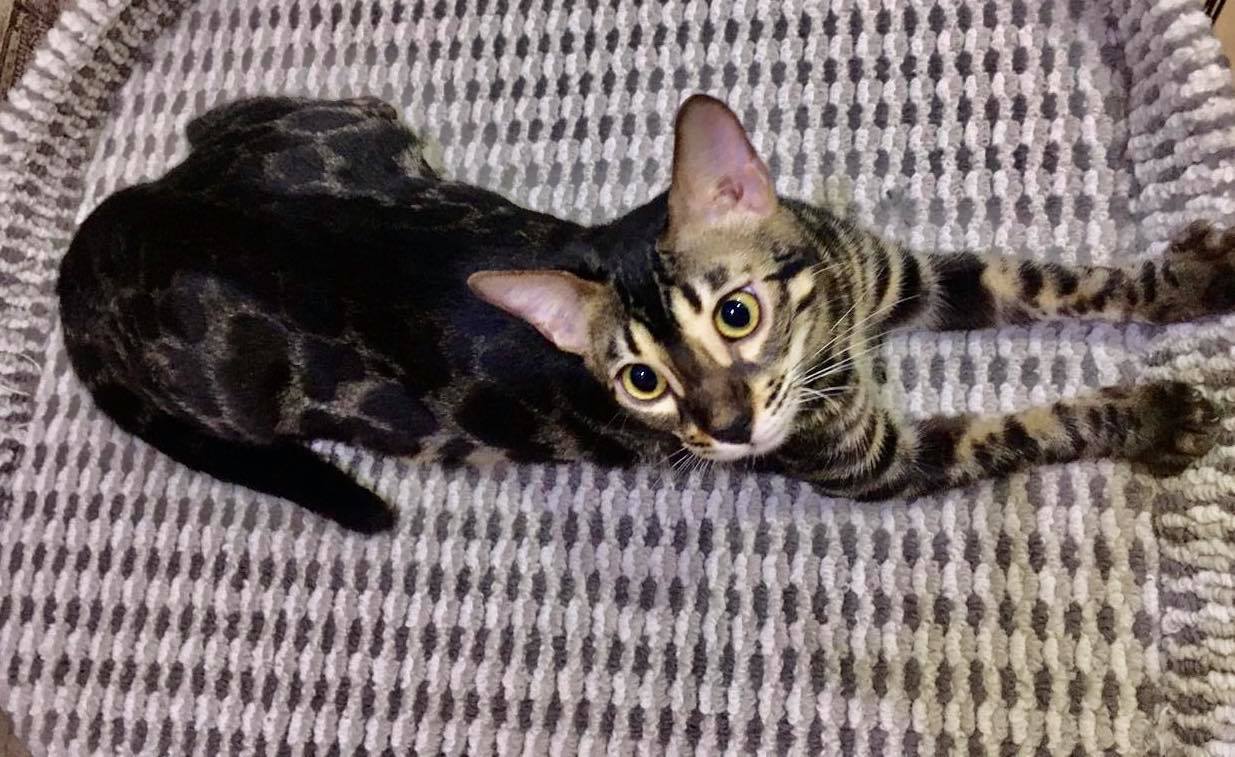 |  |
MARBLE STYLE COAT
 |  |  |
ROSETTE STYLE
 |  | 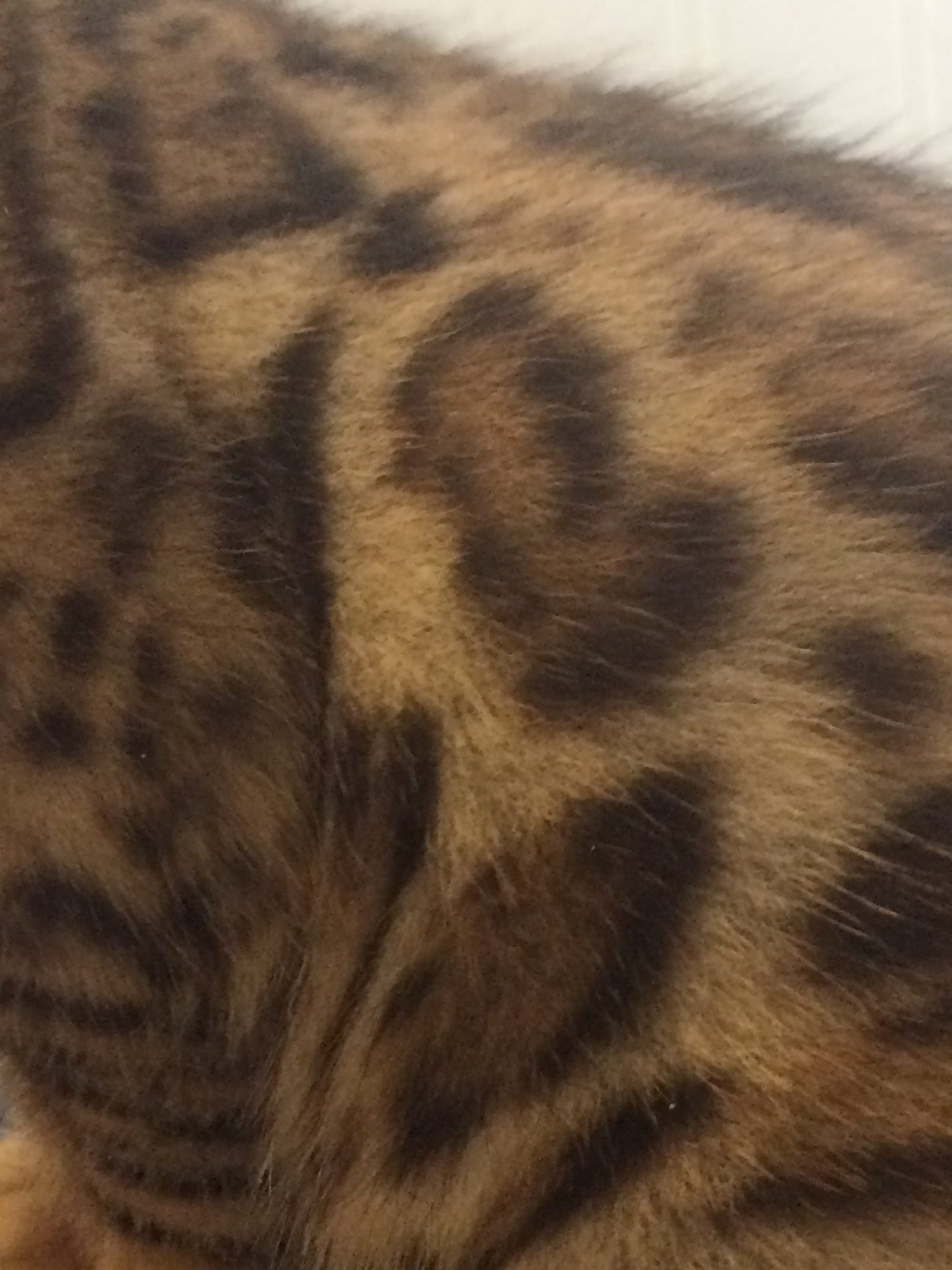 |
 |  |  |
Can you train Exotic Legends Bengals to use the toilet? Can you train Exotic Legends Bengals to sit, stay, and shake on command?
YES - Exotic Legends Bengals are not only healthy, and beautiful. They are also super smart.
Here is a post from one of our Exotic Legends Bengal Clients.

Here is a post from one of our Exotic Legends Bengal Clients.

Do you provide studding services?
NO
What do you test for and who does your testing?
SINCE BENGALS WERE CREATED BY BREEDING AN ALC (ASIAN LEOPARD CAT) TO A DOMESTIC CAT - IT IS VERY IMPORTANT TO TEST YOUR BENGALS FOR ALL CAT INHERITABLE DISEASES.
WE USE UC DAVIS & OPTIMAL SELECTION FOR OUR DNA TESTING - https://www.vgl.ucdavis.edu/
1. Progressive Retinal Atrophy (PRA) - https://vgl.ucdavis.edu/services/cat/BengalPRA.php
2. Erythrocyte Pyruvate Kinase Deficiency (PK Deficiency), - https://vgl.ucdavis.edu/services/pkdeficiency.php
3. Feline Immunodeficiency Virus (FIV) - Testing for the feline immunodeficiency virus is performed with a small sample of your cat's blood. - https://www.vet.cornell.edu/departments-centers-and-institutes/cornell-feline-health-center/health-information/feline-health-topics/feline-immunodeficiency-virus
4. Feline Leukemia Virus (FeLV). - Testing for the feline leukemia is performed with a small sample of your cat's blood. - https://pets.webmd.com/cats/facts-about-feline-leukemia-virus#1
5. HCM are completed by Woodfield DACVIM (Cardiology) - HCM - Hypertrophic cardiomyopathy is the most commonly diagnosed cardiac disease in cats. Feline Hypertrophic Cardiomyopathy (HCM) is a condition that causes the muscular walls of a cat's heart to thicken, decreasing the heart's efficiency and sometimes creating symptoms in other parts of the body.- https://icatcare.org/advice/hypertrophic-cardiomyopathy-hcm-and-testing/
6. Random FULL PCR Fecal Panel - The FilmArray gastrointestinal panel is a multiplex PCR test capable of qualitatively detecting DNA or RNA of 22 pathogens (bacteria, parasites, and viruses) - https://www.mayocliniclabs.com/test-catalog/Fees+and+Coding/63169
7. Random FULL PCR Upper Respiratory - https://zoologix.com/dogcat/Datasheets/FelineRespiratoryPanel.htm
8. Testing for over 50 genetic diseases, 20+ Traits amd more with - Optimal Selection - https://www.optimal-selection.com/optimal_selection_cats/
SINCE BENGALS WERE CREATED BY BREEDING AN ALC (ASIAN LEOPARD CAT) TO A DOMESTIC CAT - IT IS VERY IMPORTANT TO TEST YOUR BENGALS FOR ALL CAT INHERITABLE DISEASES.
9. Retinal Dystrophy (rdAc ) - an inherited late-onset blindness condition has been identified and is characterized by progressive degeneration of the photoreceptors (rods and cones) in the retina. This disease has been designated "rdAc
10. Autoimmune Lymphoproliferative Syndrome - Autoimmune lymphoproliferative syndrome (abbr. ALPS) is a lymphoproliferative disorder (LPD) distinguished by massive enlargement of lymphatic nodes and spleen caused by the accumulation of lymphocytes. The disease is caused by irregular lymphocyte apoptosis.
WE USE UC DAVIS & OPTIMAL SELECTION FOR OUR DNA TESTING - https://www.vgl.ucdavis.edu/
1. Progressive Retinal Atrophy (PRA) - https://vgl.ucdavis.edu/services/cat/BengalPRA.php
2. Erythrocyte Pyruvate Kinase Deficiency (PK Deficiency), - https://vgl.ucdavis.edu/services/pkdeficiency.php
3. Feline Immunodeficiency Virus (FIV) - Testing for the feline immunodeficiency virus is performed with a small sample of your cat's blood. - https://www.vet.cornell.edu/departments-centers-and-institutes/cornell-feline-health-center/health-information/feline-health-topics/feline-immunodeficiency-virus
4. Feline Leukemia Virus (FeLV). - Testing for the feline leukemia is performed with a small sample of your cat's blood. - https://pets.webmd.com/cats/facts-about-feline-leukemia-virus#1
5. HCM are completed by Woodfield DACVIM (Cardiology) - HCM - Hypertrophic cardiomyopathy is the most commonly diagnosed cardiac disease in cats. Feline Hypertrophic Cardiomyopathy (HCM) is a condition that causes the muscular walls of a cat's heart to thicken, decreasing the heart's efficiency and sometimes creating symptoms in other parts of the body.- https://icatcare.org/advice/hypertrophic-cardiomyopathy-hcm-and-testing/
6. Random FULL PCR Fecal Panel - The FilmArray gastrointestinal panel is a multiplex PCR test capable of qualitatively detecting DNA or RNA of 22 pathogens (bacteria, parasites, and viruses) - https://www.mayocliniclabs.com/test-catalog/Fees+and+Coding/63169
- Feline enteric coronavirus
- Feline panleukopenia virus / Canine parvovirus
- Campylobacter screen
- Clostridium
- Cryptosporidium screen
- Giardia screen
- Salmonella screen
- Toxoplasma gondii
- Tritrichomonas
7. Random FULL PCR Upper Respiratory - https://zoologix.com/dogcat/Datasheets/FelineRespiratoryPanel.htm
- Bordetella bronchiseptica
- Chlamydophila felis
- Feline calicivirus (FCV)
- Feline herpesvirus 1 (FHV-1; also known as feline rhinotracheitis virus)
- Influenza type A
- Mycoplasma felis
8. Testing for over 50 genetic diseases, 20+ Traits amd more with - Optimal Selection - https://www.optimal-selection.com/optimal_selection_cats/
SINCE BENGALS WERE CREATED BY BREEDING AN ALC (ASIAN LEOPARD CAT) TO A DOMESTIC CAT - IT IS VERY IMPORTANT TO TEST YOUR BENGALS FOR ALL CAT INHERITABLE DISEASES.
9. Retinal Dystrophy (rdAc ) - an inherited late-onset blindness condition has been identified and is characterized by progressive degeneration of the photoreceptors (rods and cones) in the retina. This disease has been designated "rdAc
10. Autoimmune Lymphoproliferative Syndrome - Autoimmune lymphoproliferative syndrome (abbr. ALPS) is a lymphoproliferative disorder (LPD) distinguished by massive enlargement of lymphatic nodes and spleen caused by the accumulation of lymphocytes. The disease is caused by irregular lymphocyte apoptosis.
What type of food/water does your Exotic Legends Bengal eat?
We feed our Adult Bengals - Purina ONE Natural Tender Selects Blend with Real Salmon Dry Cat Food - https://www.petco.com/shop/en/petcostore/product/purina-one-salmon-and-tuna-flavor-cat-food-870552
Our kittens go from nursing to Purina Pro Plan Kitten wet food-
https://www.chewy.com/purina-pro-plan-focus-kitten/dp/182005
Our kittens also get fed - FREE FED (left out 24/7) - Purina ONE +Plus High Protein Natural Healthy Kitten Formula Dry Kitten Food
https://www.petco.com/shop/en/petcostore/product/purina-one-healthy-kitten-food-16-lbs-2512931
We put water (well) water in a bowl for the kittens.
They also use the following fountain (with bottled water):
https://www.chewy.com/drinkwell-avalon-ceramic-dog-cat/dp/48110?utm_source=google-product&utm_medium=cpc&utm_campaign=hg&utm_content=Drinkwell&utm_term=&gclid=Cj0KCQjwhb36BRCfARIsAKcXh6HensFNQxJZMXjPztMuqmhHDPg78NU3MeYf1Boj0svNovhCszSdJ4QaApToEALw_wcB

Our kittens go from nursing to Purina Pro Plan Kitten wet food-
https://www.chewy.com/purina-pro-plan-focus-kitten/dp/182005
Our kittens also get fed - FREE FED (left out 24/7) - Purina ONE +Plus High Protein Natural Healthy Kitten Formula Dry Kitten Food
https://www.petco.com/shop/en/petcostore/product/purina-one-healthy-kitten-food-16-lbs-2512931
We put water (well) water in a bowl for the kittens.
They also use the following fountain (with bottled water):
https://www.chewy.com/drinkwell-avalon-ceramic-dog-cat/dp/48110?utm_source=google-product&utm_medium=cpc&utm_campaign=hg&utm_content=Drinkwell&utm_term=&gclid=Cj0KCQjwhb36BRCfARIsAKcXh6HensFNQxJZMXjPztMuqmhHDPg78NU3MeYf1Boj0svNovhCszSdJ4QaApToEALw_wcB

Why we do NOT feed RAW (RAW IS A NO NO FOR NOT ONLY HUMANS BUT PETS)
https://vet.tufts.edu/wp-content/uploads/raw_meat_diets_memo.pdf
CLICK ON ALL THESE STUDIES AND READ THEM - THERE ARE HUNDREDS OF STUDIES LIKE THESE
REAL STUDIES - REAL DOCTORS OF VET MEDICINE
Bacteria and Viruses
Bacteria and viruses are the most common cause of food poisoning. The symptoms and severity of food poisoning vary, depending on which bacteria or virus has contaminated the food.
To prevent illness, always follow the food safety steps: clean, separate, cook, and chill. Other prevention tips for specific bacteria and viruses are included below.
The bacteria and viruses that cause the most illnesses, hospitalizations, or deaths in the United States are described below and include:
https://www.veterinarypracticenews.com/debating-raw-diets-january-2019/
https://www.avma.org/raw-pet-foods-and-avmas-policy-faq
https://veterinaryrecord.bmj.com/content/181/15/384.2
Raw meat can carry life-threatening pathogens, he told them – Salmonella, E coli, Campylobacter, Listeria, Clostridium and norovirus. Pets eating infected meat can become ill themselves or shed pathogens into the environment for potential transmission and harm to others. The biggest threat is Salmonella. It causes the most hospital admissions and around 200 deaths per year in the UK. It can only be killed by heat.
https://www.avvets.com/sites/site-4271/documents/Raw%20Meat%20Diets%20pdf.pdf
https://skeptvet.com/Blog/2018/02/yet-another-study-shows-the-real-dangers-of-raw-diets-for-dogs/
There is evidence of risk in feeding raw, including infectious disease, parasites, and injury from raw bones. There is no scientific evidence, only anecdote and dubious theories, to demonstrate any benefits from feeding raw.
A new study has recently been published which adds to the already considerable evidence of risk from infectious disease.
Martinez-Anton, L., Marenda, M., Firestone, S.M., Bushell, R.N., Child, G., Hamilton, A.I., Long, S.N. and Le Chevoir, M.A.R. (2018), Investigation of the Role of Campylobacter Infection in Suspected Acute Polyradiculoneuritis in Dogs. J Vet Intern Med, 32: 352–360.
https://onlinelibrary.wiley.com/doi/full/10.1111/jvim.15030
https://vetmed.illinois.edu/pet_column/raw-diets-whats-risk/
Salmonella and E. coli are pathogens commonly found in raw meat.
The words “raw diet” brings thoughts of uncooked vegetables and meat to mind. The raw food craze has been popular among people, but is it safe to feed our animals a raw diet too?
According to Dr. Jack Herrmann, a veterinarian on faculty at the University of Illinois College of Veterinary Medicine in Urbana, as well as the director of the college’s Center for One Health Illinois, pet owners should know the risks when feeding raw meat to their animals.
Salmonella and E. coli are pathogens—infectious agents that can cause disease or illness—commonly found in raw meat. The best way to prevent illness from these pathogens in animals and people is to cook meat at a high enough temperature to kill pathogens.
CLICK ON ALL THESE STUDIES AND READ THEM - THERE ARE HUNDREDS OF STUDIES LIKE THESE
REAL STUDIES - REAL DOCTORS OF VET MEDICINE
Bacteria and Viruses
Bacteria and viruses are the most common cause of food poisoning. The symptoms and severity of food poisoning vary, depending on which bacteria or virus has contaminated the food.
To prevent illness, always follow the food safety steps: clean, separate, cook, and chill. Other prevention tips for specific bacteria and viruses are included below.
The bacteria and viruses that cause the most illnesses, hospitalizations, or deaths in the United States are described below and include:
- Campylobacter
- Clostridium perfringens
- E. coli
- Listeria
- Norovirus
- Salmonella
- Bacillus cereus
- Botulism
- Hepatitis A
- Shigella
- Staphylococcus aureus (Staphylococcal [Staph] Food Poisoning)
- Vibrio Species Causing Vibriosis
https://www.veterinarypracticenews.com/debating-raw-diets-january-2019/
https://www.avma.org/raw-pet-foods-and-avmas-policy-faq
https://veterinaryrecord.bmj.com/content/181/15/384.2
Raw meat can carry life-threatening pathogens, he told them – Salmonella, E coli, Campylobacter, Listeria, Clostridium and norovirus. Pets eating infected meat can become ill themselves or shed pathogens into the environment for potential transmission and harm to others. The biggest threat is Salmonella. It causes the most hospital admissions and around 200 deaths per year in the UK. It can only be killed by heat.
https://www.avvets.com/sites/site-4271/documents/Raw%20Meat%20Diets%20pdf.pdf
https://skeptvet.com/Blog/2018/02/yet-another-study-shows-the-real-dangers-of-raw-diets-for-dogs/
There is evidence of risk in feeding raw, including infectious disease, parasites, and injury from raw bones. There is no scientific evidence, only anecdote and dubious theories, to demonstrate any benefits from feeding raw.
A new study has recently been published which adds to the already considerable evidence of risk from infectious disease.
Martinez-Anton, L., Marenda, M., Firestone, S.M., Bushell, R.N., Child, G., Hamilton, A.I., Long, S.N. and Le Chevoir, M.A.R. (2018), Investigation of the Role of Campylobacter Infection in Suspected Acute Polyradiculoneuritis in Dogs. J Vet Intern Med, 32: 352–360.
https://onlinelibrary.wiley.com/doi/full/10.1111/jvim.15030
https://vetmed.illinois.edu/pet_column/raw-diets-whats-risk/
Salmonella and E. coli are pathogens commonly found in raw meat.
The words “raw diet” brings thoughts of uncooked vegetables and meat to mind. The raw food craze has been popular among people, but is it safe to feed our animals a raw diet too?
According to Dr. Jack Herrmann, a veterinarian on faculty at the University of Illinois College of Veterinary Medicine in Urbana, as well as the director of the college’s Center for One Health Illinois, pet owners should know the risks when feeding raw meat to their animals.
Salmonella and E. coli are pathogens—infectious agents that can cause disease or illness—commonly found in raw meat. The best way to prevent illness from these pathogens in animals and people is to cook meat at a high enough temperature to kill pathogens.
How can I get onto your waiting list?
1. Click and Complete the waiting list form - WAITING LIST TAB
2. Place a non-refundable (Gift) application fee of $200 - we except
3. Second non-refundable (Gift) deposits are BY CASH AP ONLY -
You will be given 1 day to make your selection - from the time I notify you are next in line (by e-mail and/or phone). - If you decide to pass and wait for another litter - your name will remain on the list - your deposit will go towards the purchases price of your kitten and your name will be placed at the bottom of the list. If you decide you no longer want a kitten - OR we are unable to contact you via the e-mail you provided on your waiting list application - your deposits are non refundable and you will be removed from the list.
WE CAN NOT GUARANTEE WHEN A LITTER - OR KITTENS WILL BE BORN - OR IF MATING'S TOOK OR DID NOT TAKE - NO ONE CAN
Memberships and affiliates?
TICA - www.tica.org
CFA - The Cat Fanciers' Association INC. https://ecat.cfa.org/public/catterylist.aspx?startswith=E
Bengal Cat Club - https://bengalcatclub/bengal-cat-breeders/washington
Cat Kingpin - www.catkingpin.com
CFA - The Cat Fanciers' Association INC. https://ecat.cfa.org/public/catterylist.aspx?startswith=E
Bengal Cat Club - https://bengalcatclub/bengal-cat-breeders/washington
Cat Kingpin - www.catkingpin.com
How are Exotic Legends Bengals with young kids and young adults?
Kittens/cats are like people. No two are the same. They have their own purrrrsonailities. My kittens are great with kids. They are socialized from birth. Here are pictures of our clients with their Exotic Legends Bengals and their children.
 |  |  |  |
 |  |  |  |
 |  |  |  |
How are Exotic Legends Bengals with other pets?
Kittens/cats are like people. No two are the same. They have their own purrrrsonalilities. My kittens are great with other animals. We have German Shepherds that are their personal guard dogs. Here are pictures of our clients with their Exotic Legends Bengals and their other fur babies.

 | 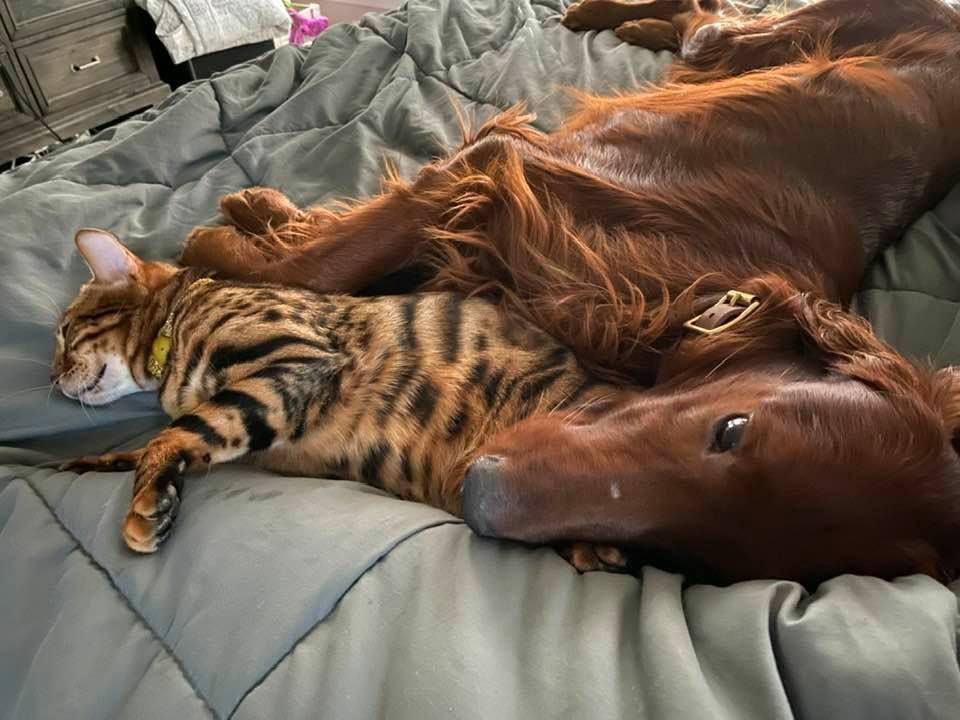 |  |
 |  |  |
 |  |  |

What litter do your cats use?
Tractor Supply Pine Pellet Stall Bedding will save you time, storage space and money. Made from environmentally friendly, all natural pine, our Pine Pellet Stall Bedding provides a comfortable sterile bedding layer, while neutralizing odor and absorbing moisture on contact.
https://www.tractorsupply.com/tsc/product/tractor-supply-pine-pellet-stall-bedding-40-lb?cm_vc=-10005
https://www.tractorsupply.com/tsc/product/tractor-supply-pine-pellet-stall-bedding-40-lb?cm_vc=-10005
Things you could buy for your new Bengal - that they wold enjoy
1. A CAT WHEEL - These are great. This is the BEST wheel on the market today. 5 out of 5 stars on Facebook. NUMBER 1 CAT WHEEL ON FLUFFY PLANET It helps your Bengal exercise - if you do not take your kitties for walks or the weather is bad outside and you can not walk them, or you live in an apartment - these will be great for you and your Bengal.
If you click on the link-
https://www.ziggydoo.com/en/home/8-ferris-cat-exercise-wheel.html
FROM ZIGGYDOO - "Simply ask your customers to add a note or comment to their order to inform me that they were referred by your cattery name".
Exotic Legends can get credits towards another wheel for our cattery. The price is the same whether you use our link or not - but we hope that you will use the link - so that Exotic legends gets the credit.

ORDER NOW - GREAT COLORS TO PICK FROM
https://www.ziggydoo.com/en/breeders/254-ferris-cat-exercise-wheel.html

2. Cat Hammock - Cats love to be elevated, and a cat hammock gives your kitty a dedicated place to be while lounging. While a cat hammock is not a need when you get a cat, it makes a nice accessory for them and can keep them from getting into trouble elsewhere in your home.
This is one that we enjoy - CatastrophiCreations Fabric Raceway Hammock Lounger Wall-Mounted Cat Shelving
There are several different sites that you can order this from -

3. Interactive Cat Toys - There are so many on the market right now to choose from. This one is my pick - MalsiPree Robotic Interactive Cat Toy, Automatic Feather/Ball Teaser Toys for Kitten/Cats, USB Rechargeable Electronic Kitty Toy, Large Capacity Battery, All Floors/Carpet Available, 4 Bonus Feathers
You can find it on Amazon - https://www.amazon.com/dp/B07Z78F4R5?pd_rd_i=B07Z78F4R5&pd_rd_w=X41xR&pf_rd_p=b191e068-35f0-4c8b-a540-78dd3ab8cd44&pd_rd_wg=4Wy1v&pf_rd_r=H63FZ5BG4NB1X4HG0H6M&pd_rd_r=0a26243e-646a-444a-b308-319ad616e032

MEWTOGO 8 Pack Swimming Robot Fish Toy-Moving Interactive Fish Toys Wiggle Fish Catnip Toys for Cats and Kids
https://www.amazon.com/MEWTOGO-Swimming-Toy-Moving-Interactive-Wiggle/dp/B086WRVFF6/ref=asc_df_B086WRVFF6/?tag=hyprod-20&linkCode=df0&hvadid=459503386713&hvpos=&hvnetw=g&hvrand=8790281243169040777&hvpone=&hvptwo=&hvqmt=&hvdev=c&hvdvcmdl=&hvlocint=&hvlocphy=9033507&hvtargid=pla-943979105504&psc=1

If you click on the link-
https://www.ziggydoo.com/en/home/8-ferris-cat-exercise-wheel.html
FROM ZIGGYDOO - "Simply ask your customers to add a note or comment to their order to inform me that they were referred by your cattery name".
Exotic Legends can get credits towards another wheel for our cattery. The price is the same whether you use our link or not - but we hope that you will use the link - so that Exotic legends gets the credit.

ORDER NOW - GREAT COLORS TO PICK FROM
https://www.ziggydoo.com/en/breeders/254-ferris-cat-exercise-wheel.html

2. Cat Hammock - Cats love to be elevated, and a cat hammock gives your kitty a dedicated place to be while lounging. While a cat hammock is not a need when you get a cat, it makes a nice accessory for them and can keep them from getting into trouble elsewhere in your home.
This is one that we enjoy - CatastrophiCreations Fabric Raceway Hammock Lounger Wall-Mounted Cat Shelving
There are several different sites that you can order this from -

3. Interactive Cat Toys - There are so many on the market right now to choose from. This one is my pick - MalsiPree Robotic Interactive Cat Toy, Automatic Feather/Ball Teaser Toys for Kitten/Cats, USB Rechargeable Electronic Kitty Toy, Large Capacity Battery, All Floors/Carpet Available, 4 Bonus Feathers
You can find it on Amazon - https://www.amazon.com/dp/B07Z78F4R5?pd_rd_i=B07Z78F4R5&pd_rd_w=X41xR&pf_rd_p=b191e068-35f0-4c8b-a540-78dd3ab8cd44&pd_rd_wg=4Wy1v&pf_rd_r=H63FZ5BG4NB1X4HG0H6M&pd_rd_r=0a26243e-646a-444a-b308-319ad616e032

MEWTOGO 8 Pack Swimming Robot Fish Toy-Moving Interactive Fish Toys Wiggle Fish Catnip Toys for Cats and Kids
https://www.amazon.com/MEWTOGO-Swimming-Toy-Moving-Interactive-Wiggle/dp/B086WRVFF6/ref=asc_df_B086WRVFF6/?tag=hyprod-20&linkCode=df0&hvadid=459503386713&hvpos=&hvnetw=g&hvrand=8790281243169040777&hvpone=&hvptwo=&hvqmt=&hvdev=c&hvdvcmdl=&hvlocint=&hvlocphy=9033507&hvtargid=pla-943979105504&psc=1

Can I train my Exotic Legends Bengal to walk on a leash?
YES - THESE ARE ALL PICTURES OF EXOTIC LEGENDS BENGALS ON A HARNESS AND LEASH
This site has great pointers to help you train your Bengal
https://www.thesprucepets.com/how-to-leash-train-cats-551823
Choosing a Collar or Harness for Leash Training Your Cat
Collars are good for cats for identification purposes and to hang a bell on, but not great to use with a leash. Cats are built differently than dogs and they can easily slip out of a collar that is attached to a leash. Harnesses are much more secure for walking a cat with, especially when you are first training it.
Choose a harness that fits securely and is snug but not too tight on your cat. You can check to make sure it isn’t too tight by sliding two fingers underneath the harness. If two fingers can slide between the harness and your cat, then it should fit correctly. But if you can fit more fingers or fewer fingers under the harness, it may be too loose or tight.
Harnesses that are specifically designed for cats work best. If a harness is uncomfortable, your cat will only think about how poorly it fits or how difficult it is to walk in. Harnesses that are made from a soft material, cut in a way to allow a cat to walk normally, and that are lightweight are your best options for your cat. Make sure the harness you choose also has a D-ring securely attached to the back of it as well since this is where you will attach the leash.
Choosing a Leash for Your Cat
Lightweight leashes that are 4 to 6 feet long are ideal for leash training cats of all sizes. Retractable leashes and leashes that are longer are okay to use once a cat is trained but stick to a manageable length and leash weight at first.
Let Your Cat Adjust to the Harness
Once your cat has an appropriately sized harness on, allow it to get used to it. Let your cat sniff it and give it treats while it does so.
Keep in mind that the length of time that it takes for a cat to get used to wearing a harness will vary from cat to cat. A harness may not bother your cat at all or it may take several hours or days for your cat to adjust. Be sure to praise your cat and give it treats while it has the harness on. Do not leave the harness on for more than a few minutes if your cat is frightened by it, but increase the time it spends wearing the harness each time you put it on. Work your way up to leaving the harness on for an hour. If your cat is walking around normally while wearing the harness, then you are ready to take the next step in leash training.
Let Your Cat Adjust to the Leash
If your cat doesn’t mind wearing the harness, go ahead and attach the leash to the D-ring. While still in the safety of your home, allow your cat to drag the leash around to get used to being attached to it. If your cat is easily spooked, you may want to instead attach the leash and hold it while still allowing your cat to move about freely. Some cats are scared of a leash dragging behind them and you wouldn’t want to cause your cat to be immediately frightened of the leash. Once your cat is used to the leash being connected to it, you can advance to the outdoors.
Teach Your Cat to Walk on a Leash
Continue to hold the leash and let your cat walk freely outside. Coax your cat to walk where you want it to walk using treats or toys. Don’t pull your cat by the leash, but a gentle tug to redirect its attention is okay. You should continuously praise your cat with treats if it is walking in the direction you seek.
Over time your cat will get used to the sights, sounds, smells, and experiences of the outdoors and will be safe in its harness and leash. This may take several days or weeks for some cats, while others will be more comfortable right away.
Make Sure Your Cat Is Safe
Cats that spend time outdoors are more likely to get fleas, ticks, heartworms, and other parasites. Discuss preventative options with your vet to make sure your cat is safe and protected while enjoying time outside.
Stay away from things that may startle your cat, such as busy roads and barking dogs, while outside. Even though a cat may be trained to walk on a leash, different situations may scare it and cause it to be afraid of going on a future walk.
This site has great pointers to help you train your Bengal
https://www.thesprucepets.com/how-to-leash-train-cats-551823
Choosing a Collar or Harness for Leash Training Your Cat
Collars are good for cats for identification purposes and to hang a bell on, but not great to use with a leash. Cats are built differently than dogs and they can easily slip out of a collar that is attached to a leash. Harnesses are much more secure for walking a cat with, especially when you are first training it.
Choose a harness that fits securely and is snug but not too tight on your cat. You can check to make sure it isn’t too tight by sliding two fingers underneath the harness. If two fingers can slide between the harness and your cat, then it should fit correctly. But if you can fit more fingers or fewer fingers under the harness, it may be too loose or tight.
Harnesses that are specifically designed for cats work best. If a harness is uncomfortable, your cat will only think about how poorly it fits or how difficult it is to walk in. Harnesses that are made from a soft material, cut in a way to allow a cat to walk normally, and that are lightweight are your best options for your cat. Make sure the harness you choose also has a D-ring securely attached to the back of it as well since this is where you will attach the leash.
Choosing a Leash for Your Cat
Lightweight leashes that are 4 to 6 feet long are ideal for leash training cats of all sizes. Retractable leashes and leashes that are longer are okay to use once a cat is trained but stick to a manageable length and leash weight at first.
Let Your Cat Adjust to the Harness
Once your cat has an appropriately sized harness on, allow it to get used to it. Let your cat sniff it and give it treats while it does so.
Keep in mind that the length of time that it takes for a cat to get used to wearing a harness will vary from cat to cat. A harness may not bother your cat at all or it may take several hours or days for your cat to adjust. Be sure to praise your cat and give it treats while it has the harness on. Do not leave the harness on for more than a few minutes if your cat is frightened by it, but increase the time it spends wearing the harness each time you put it on. Work your way up to leaving the harness on for an hour. If your cat is walking around normally while wearing the harness, then you are ready to take the next step in leash training.
Let Your Cat Adjust to the Leash
If your cat doesn’t mind wearing the harness, go ahead and attach the leash to the D-ring. While still in the safety of your home, allow your cat to drag the leash around to get used to being attached to it. If your cat is easily spooked, you may want to instead attach the leash and hold it while still allowing your cat to move about freely. Some cats are scared of a leash dragging behind them and you wouldn’t want to cause your cat to be immediately frightened of the leash. Once your cat is used to the leash being connected to it, you can advance to the outdoors.
Teach Your Cat to Walk on a Leash
Continue to hold the leash and let your cat walk freely outside. Coax your cat to walk where you want it to walk using treats or toys. Don’t pull your cat by the leash, but a gentle tug to redirect its attention is okay. You should continuously praise your cat with treats if it is walking in the direction you seek.
Over time your cat will get used to the sights, sounds, smells, and experiences of the outdoors and will be safe in its harness and leash. This may take several days or weeks for some cats, while others will be more comfortable right away.
Make Sure Your Cat Is Safe
Cats that spend time outdoors are more likely to get fleas, ticks, heartworms, and other parasites. Discuss preventative options with your vet to make sure your cat is safe and protected while enjoying time outside.
Stay away from things that may startle your cat, such as busy roads and barking dogs, while outside. Even though a cat may be trained to walk on a leash, different situations may scare it and cause it to be afraid of going on a future walk.
 |  |  |  |
 |  |  |  |
 |  |  | 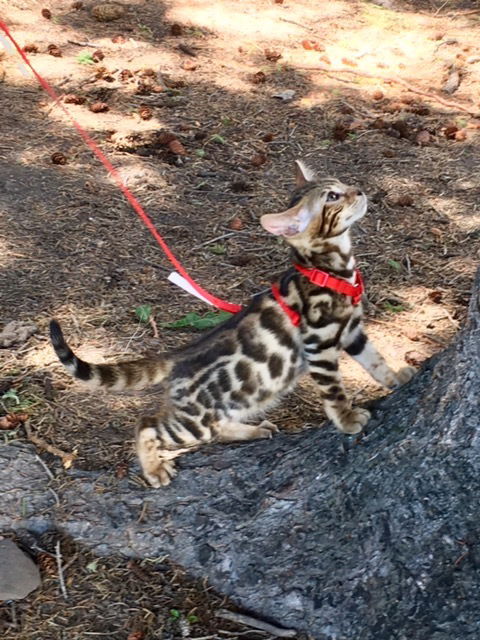 |
Why are Bengals expensive?
A LOT GOES INTO THE PRICE OF A BENGAL -
Costs
There are many things that go into the price of Bengal kittens
1. Costs of purchasing top quality Bengals with good healthy bloodlines and Breeding Rights
2. Cost to transport breeding kitten
3. Cost to separate – house your new cat until a vet has seen them and tests results come back
4. Test for the following
a. All 50 Genetic Cat Disorder
b. Feline Aids and Leukemia
c. Fecal PCR Panel – OVER $536 JUST FOR THIS ONE TEST
d. Upper Respiratory Panel
e. HCM
KEEP IN MIND IF RESULTS ARE BAD – YOU CAN NOT USE THE CAT AND YOU LOST ALL THAT MONEY – AND IT HAPPENS… I HAVE SPEND THOUSANDS ON A CAT – DNA TESTS, HCM, ULTRASOUNDS, BLOOD WORK.. - JUST TO FIND OUT THE CATTERY WAS UNETHICAL AND I HAD TO FIX THE BREEDER I BOUGHT – MIND YOU THIS OTHER CATTERY DID NOT REPLACE THE KITTEN OR REFUND ME ANY MONEY…
5. Microchip breeder
6. Security cameras and a monitored security system.
7. Cat carriers
8. Costs of "quality food"
9. Cat litter
10. Multiple litter boxes.
11. Air filters
12. Emergency vet expenses – Which could include complication during birth
13. Kitten toys
14. Cat Exercise Wheel - A must...
15. Cat Trees - Also a must
16. Bedding
17. Safe detergent for animal bedding
18. Bengal organization fees (TICA)
19. Bengal organization fees (CFA)
20. Bengal organization fees (TIBCS)
21, Fees to have your cattery inspected
22. Advertising fees
23. Website fees
24. De-Wormer
25. Flea treatments
26. Kitten collars
27. Cat collars
28. Bottles
29. Kitten formula
30. Vaccinations like rabies, FIV, Leukemia and possibly others depending on your Vets advice and your preference.
31. Fees to fix the cats
32. Products that are bought for Kitten Care packages
The list goes on...
33. Cat plants
34. Catio – for play time
35. Register litters fees
36. Cat show fees
37. Cat show supplies
AND SO MUCH MORE
DO NOT FORGET HOW MUCH TIME WE SPEND ON THE CATS - EVERYDAY WE HAVE TO CLEAN, AND CARE FOR THE CATS. ANSWER E-MAILS AND CALLS. RESEARCH FOR UPDATED INFORMATION ON THE BREED. STAY EDUCATED. BE PART OF THE BENGAL COMMUNITY.
THIS TAKE MANY HOURS EACH AND EVERY DAY
Costs
There are many things that go into the price of Bengal kittens
1. Costs of purchasing top quality Bengals with good healthy bloodlines and Breeding Rights
2. Cost to transport breeding kitten
3. Cost to separate – house your new cat until a vet has seen them and tests results come back
4. Test for the following
a. All 50 Genetic Cat Disorder
b. Feline Aids and Leukemia
c. Fecal PCR Panel – OVER $536 JUST FOR THIS ONE TEST
d. Upper Respiratory Panel
e. HCM
KEEP IN MIND IF RESULTS ARE BAD – YOU CAN NOT USE THE CAT AND YOU LOST ALL THAT MONEY – AND IT HAPPENS… I HAVE SPEND THOUSANDS ON A CAT – DNA TESTS, HCM, ULTRASOUNDS, BLOOD WORK.. - JUST TO FIND OUT THE CATTERY WAS UNETHICAL AND I HAD TO FIX THE BREEDER I BOUGHT – MIND YOU THIS OTHER CATTERY DID NOT REPLACE THE KITTEN OR REFUND ME ANY MONEY…
5. Microchip breeder
6. Security cameras and a monitored security system.
7. Cat carriers
8. Costs of "quality food"
9. Cat litter
10. Multiple litter boxes.
11. Air filters
12. Emergency vet expenses – Which could include complication during birth
13. Kitten toys
14. Cat Exercise Wheel - A must...
15. Cat Trees - Also a must
16. Bedding
17. Safe detergent for animal bedding
18. Bengal organization fees (TICA)
19. Bengal organization fees (CFA)
20. Bengal organization fees (TIBCS)
21, Fees to have your cattery inspected
22. Advertising fees
23. Website fees
24. De-Wormer
25. Flea treatments
26. Kitten collars
27. Cat collars
28. Bottles
29. Kitten formula
30. Vaccinations like rabies, FIV, Leukemia and possibly others depending on your Vets advice and your preference.
31. Fees to fix the cats
32. Products that are bought for Kitten Care packages
The list goes on...
33. Cat plants
34. Catio – for play time
35. Register litters fees
36. Cat show fees
37. Cat show supplies
AND SO MUCH MORE
DO NOT FORGET HOW MUCH TIME WE SPEND ON THE CATS - EVERYDAY WE HAVE TO CLEAN, AND CARE FOR THE CATS. ANSWER E-MAILS AND CALLS. RESEARCH FOR UPDATED INFORMATION ON THE BREED. STAY EDUCATED. BE PART OF THE BENGAL COMMUNITY.
THIS TAKE MANY HOURS EACH AND EVERY DAY
Can we come to your home to see the cattery
Due to COVID 19 - and since we are an LLC - Because of Health/Liability/Insurance reasons we do not allow individuals to come to our home. (Liability Insurance for a LLC Cattery is VERY expensive and we do not want to have to raise the prices of our Bengals to off set the insurance fees)
We can Face-time and Zoom any time that you would like.
We can deliver your kitten to you or meet you at an agreed upon location. (Depending on distance - a travel fee maybe added to the price of your kitten/cat).
We also offer a DOOR TO DOOR service (if it is to far for you to travel you can use a flight nanny (you would have to get their price from them)or we can deliver, for a fee of .56 cents a mile (Current IRS Rate) (again, this depends on the distance)
We also have recommendations posted on our site.
We also have YEARLY inspections from a licensed Veterinarian - to ensure that we are taking care of the cats properly. We post our verification/awards from CFA and/or TICA of the inspection results, under our CERTIFICATES AND AWARDS tab - on our website.
WE RECEIVED THE 2022 - 2023 & 2021 - 2022 & 2020 - 2021 CFA Cattery of Excellence award - The Cat Fanciers' Association (CFA) has a program whereby a cattery may obtain certification from the CFA for adhering to a standard of care of their cats. We are proud to say, we have received the distinction of "Cattery of Excellence" every year since 2020 when we first applied.
WE RECEIVED THE 2022 - 2023 & 2021 - 2022 & 2020 - 2021 TICA Outstanding Cattery
TICA'S EXPLANATION OF THE CERTIFICATES - "In keeping with the Mission and Policy Statements of TICA, the Outstanding Cattery Program has adopted the Cattery Evaluation Program and the Outstanding Cattery Code of Ethics as requirements for achieving the TICA Outstanding Cattery certificate. The goal is to provide education, information, and guidance to breeders so that they are aware of proper husbandry and cattery management techniques. Evaluator The actual cattery evaluation must be done by a licensed small animal veterinarian. The breeder may engage his/her regular veterinarian for this task. It is important for the veterinarian to place emphasis on the overall impression of health and well-being of the cats in the cattery during the evaluation and decision-making process. Often cattery set-ups involve the entire household. For example, bedrooms and bathrooms may be utilized for birthing and/or isolation areas of the cattery. In addition, it is important for the evaluator to allow for the odor of any whole male cat in residence. However, it is not allowable to experience the stale odor of cats permeating the residence. It is hoped that the dialogue between the veterinarian and breeder will be an educational experience. Breeder The breeder is encouraged to use the Cattery Evaluation Form as a guide for self-evaluation of his/her cattery prior to contacting a veterinarian. It is hoped that this method will allow the breeder to correct any deficiencies before the actual evaluation. The breeder must be present during the evaluation and scoring process. All fees charged by the veterinarian for this service are to be paid by the breeder. Scoring Method The veterinarian is to complete and score the form in the presence of the breeder. Complete the form by ticking the appropriate box against each of the criteria. Each individual rating of "Excellent" receives 2 points, each "Satisfactory" receives 1 point, and each "unsatisfactory" rating receives 0 points. Any Not Applicable (N/A) rating receives a score of 2 points. Multiply the total number of "excellent" ratings plus "N/A" ratings by 2 and enter this figure on the line following "Excellent". Add the total number of "Satisfactory" ratings and enter this figure on the line following "Satisfactory". Add the two figures together and enter the sum in the appropriate space as the total score. The best possible score is 88 points. A total score of 75 points or more receives an overall "Outstanding" rating and the breeder will be sent a TICA Outstanding Cattery certificate."
https://tica.org/owners-breeders/catteries/outstanding-cattery-program
We can Face-time and Zoom any time that you would like.
We can deliver your kitten to you or meet you at an agreed upon location. (Depending on distance - a travel fee maybe added to the price of your kitten/cat).
We also offer a DOOR TO DOOR service (if it is to far for you to travel you can use a flight nanny (you would have to get their price from them)or we can deliver, for a fee of .56 cents a mile (Current IRS Rate) (again, this depends on the distance)
We also have recommendations posted on our site.
We also have YEARLY inspections from a licensed Veterinarian - to ensure that we are taking care of the cats properly. We post our verification/awards from CFA and/or TICA of the inspection results, under our CERTIFICATES AND AWARDS tab - on our website.
WE RECEIVED THE 2022 - 2023 & 2021 - 2022 & 2020 - 2021 CFA Cattery of Excellence award - The Cat Fanciers' Association (CFA) has a program whereby a cattery may obtain certification from the CFA for adhering to a standard of care of their cats. We are proud to say, we have received the distinction of "Cattery of Excellence" every year since 2020 when we first applied.
WE RECEIVED THE 2022 - 2023 & 2021 - 2022 & 2020 - 2021 TICA Outstanding Cattery
TICA'S EXPLANATION OF THE CERTIFICATES - "In keeping with the Mission and Policy Statements of TICA, the Outstanding Cattery Program has adopted the Cattery Evaluation Program and the Outstanding Cattery Code of Ethics as requirements for achieving the TICA Outstanding Cattery certificate. The goal is to provide education, information, and guidance to breeders so that they are aware of proper husbandry and cattery management techniques. Evaluator The actual cattery evaluation must be done by a licensed small animal veterinarian. The breeder may engage his/her regular veterinarian for this task. It is important for the veterinarian to place emphasis on the overall impression of health and well-being of the cats in the cattery during the evaluation and decision-making process. Often cattery set-ups involve the entire household. For example, bedrooms and bathrooms may be utilized for birthing and/or isolation areas of the cattery. In addition, it is important for the evaluator to allow for the odor of any whole male cat in residence. However, it is not allowable to experience the stale odor of cats permeating the residence. It is hoped that the dialogue between the veterinarian and breeder will be an educational experience. Breeder The breeder is encouraged to use the Cattery Evaluation Form as a guide for self-evaluation of his/her cattery prior to contacting a veterinarian. It is hoped that this method will allow the breeder to correct any deficiencies before the actual evaluation. The breeder must be present during the evaluation and scoring process. All fees charged by the veterinarian for this service are to be paid by the breeder. Scoring Method The veterinarian is to complete and score the form in the presence of the breeder. Complete the form by ticking the appropriate box against each of the criteria. Each individual rating of "Excellent" receives 2 points, each "Satisfactory" receives 1 point, and each "unsatisfactory" rating receives 0 points. Any Not Applicable (N/A) rating receives a score of 2 points. Multiply the total number of "excellent" ratings plus "N/A" ratings by 2 and enter this figure on the line following "Excellent". Add the total number of "Satisfactory" ratings and enter this figure on the line following "Satisfactory". Add the two figures together and enter the sum in the appropriate space as the total score. The best possible score is 88 points. A total score of 75 points or more receives an overall "Outstanding" rating and the breeder will be sent a TICA Outstanding Cattery certificate."
https://tica.org/owners-breeders/catteries/outstanding-cattery-program
EXOTIC LEGENDS (Bengal Cats) CHRISTMAS TREE CAT PROOFING
IT IS THAT TIME OF YEAR AGAIN - SO I THOUGHT I WOULD HELP ALL YOU CAT LOVERS OUT THERE.
EXOTIC LEGENDS (Bengal Cats) CHRISTMAS TREE CAT PROOFING -
(What do you do to cat proof your tree?)
1. Some cats do not like the smell of oranges - try putting a small amount of Citronella oil in water and spray onto the tree.
2. You can also put orange peels under the tree.
3. Make sure that your lights are well hidden in the tree.
4. Put you most loved, delicate decorations on the highest branches. Tie them to the branches with twine or string.
5. Do not have the cat in the same room as you, while you decorate.
6. Some cats do not like Bitter Apple or vinegar, you could also try to put some of these oils, vinegar in a water bottle and spray on the trees base and/or tree itself. Anti-chew products can also be found at your local pet store)
7. Most cats do not like the sound that foil makes... - try to wrap tin foil around the tree stand, and/or bottom on the tree.
8. You may want to also anchor your tree. (some use a fishing line and eye bolt - attached to the wall)
9. If you have a live tree, cover the water reservoir. You do not want your cat drinking the water. TREE SAP IS TOXIC Some people put aspirin in the water, which is TOXIC to cats. (You can use a net to put around the reservoir) Some tree stand already have covers over the reservoir.
10, You can also coat the wires with the anti chew spray, orange, or bitter apple spray.
11. Try to make sure that there are not many dangling wires... You do not want to tease your kitty.
12. Do not leave your tree on when you are not home or in the room.
13. You can get a PVC pipe, cut it down the center, put your electrical cords in it... Cats will not be able to chew the wires :) - if it is out of site it is out of mind
14. If you can use only NON breakable decorations.
15. Remember edible decorations, even though they are beautiful, string pop corn, cranberries, cookie ornaments, can also be dangerous or toxic to your cat.
16. DO NOT USE TINSEL AND GARLAND
17. If you do use Garland, spray it with anti chew - and be sure to secure it, so that it is not use to pull down.
18. Make sure you play with your cat be release some of their energy.
19. You can put some paper bags around the tree, so that your cat will play with them and take their minds off of the tree.
20. Remember your cat likes to climb, so if you do not have a cat tree, it maybe time to get one.
AS YOUR CAT GROWS HOPEFULLY YOU WILL BE ABLE TO LOOSEN UP ON YOUR SECURITY MEASURES
EXOTIC LEGENDS BENGAL CATS WISH YOU AND YOUR FUR BABIES A VERY MERRY CHRISTMAS.


